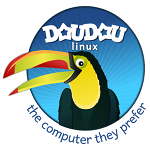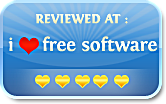 DoudouLinux
DoudouLinux
The computer they prefer!
 DoudouLinux
DoudouLinux
The computer they prefer!
The site's languages [ar] [cs] [de] [en] [es] [fa] [fr] [it] [ms] [nl] [pt] [pt_br] [ro] [ru] [sr] [sr@latin] [th] [uk] [vi] [zh]

Tips and tricks
August 2010 — last update June 2013All the versions of this article: [Deutsch] [English] [français] [italiano] [Bahasa Malaysia] [română] [русский]
Few tiny tricks may make you feel more comfortable with DoudouLinux if you plan to use it regularly in its most advanced modes. Some of these tricks should compensate for the lack of many functionalities that are often delivered by main stream computing environments.
Toggling windows to full screen
Applications are started with their window maximized whenever it is possible, in order to focus children attention on the application they have just started. This is not real full screen however since there are still the window borders. If you want to toggle to real full screen, you first need to switch the window to its normal size by double clicking on its bar on the window top or clicking the small squares at the top left of each window. Then, to toggle full screen, most of the time you just need to press the F11 key at the top of your keyboard. Pressing this key again gets you back to normal displaying.
Hiding windows
There is no area for window icons so that they cannot be “minimized”, ie. you cannot make them disappear from screen. On the other hand they can be “wound” using the mouse wheel when its cursor is above the window title bar. You can also use the small button on the left of the window title bar [1]. When a window is wound, its title bar is visible only. It is possible to move the title bar without unwinding the window.
Toggling from one window to another
As for most environments, it is possible to change the active window by pressing simultaneously the keys Alt and Tabulation. If you keep the Alt key pressed and press several times on Tabulation, you will browse all the windows one by one. The window that is about to be activated is then surrounded with a thick black border. You just have to release the Alt key when the window of interest is selected. Note: if the window is wound, it will be automatically unwound.
Toggling keyboard layout or alphabet with Alt+Shift
If your language uses a non-Latin alphabet, you may sometimes want to toggle from your alphabet to the Latin one [2]. If your keyboard is Qwerty and you are trying the French CD, you will need to switch from the default Azerty layout to the Qwerty one. To do this, you just have to press both left Alt and left Shift keys. Note: if this is still not your exact keyboard layout, you then need to use the keyboard setting tool.
On all DoudouLinux CD’s you can switch at least between Azerty, Qwerty and Qwertz layouts by pressing both left Alt and left Shift keys. The order depends on the CD default layout. For example on the French CD Azerty is the default because in France this is the official layout. Pressing Alt+Shift changes to Qwerty that is used in Belgium and in Quebec. Pressing Alt+Shift again leads to Qwertz that is used in Switzerland.
Concerning languages written with non Latin characters, the default is to use the alphabet of your language: it’s easier for children! For example in the Russian DoudouLinux version, your keyboard will type Cyrillic characters. Pressing Alt+Shift will make you type Latin characters [3], with a Qwerty layout. Pressing Alt+Shift again will switch to another Latin layout, Azerty, then Qwertz. Finally a forth Alt+Shift will get you back to Cyrillic. Note that if your language is written from right to left (eg. Arabic), switching to Latin alphabet should make characters appear from left to right and vice-versa.
Keyboard shortcuts
Some key combinations can start applications. Often they use the key called Logo, which is at the left bottom of keyboard between Ctrl and Alt. Depending on keyboards, it may represent a Windows® logo, an apple or any other sign (a home for example).
- Logo + E : launches the file manager
- Logo + D : launches the dictionary
- Logo + T : starts terminal [4]
- Logo + W : launches the web browser
Note that the command launcher [5] that was available in DoudouLinux 1.0 to 1.2 is no more working due to an unresolved issue.
Using the Alt key with mouse
The Alt key at the left bottom of keyboard provides convenient functionalities when it is pressed while the mouse is being moved:
- Alt + left button kept pressed anywhere in the application window lets you move the window without having to aim the title bar with the cursor
- Alt + middle button kept pressed anywhere in the application window lets you resize the window without having to aim the window borders with the cursor (and they are quite thin and difficult to catch).
Window resizing is then performed in a direction that depends on the window area onto which you clicked. If you rather clicked at the right top, the window gets larger to the top and to the right. If you rather clicked at left bottom, the window gets larger to the bottom and to the left, etc.
Quitting a frozen application
If you can still access its title bar, quickly click several times on its cross at the bar right. The system should detect that the application is not responding any more and should propose to close it (unsaved data are lost). If it has no effect or if you cannot access the cross, try the key combination Ctrl + Alt + Backspace. This should close your activity immediately and take you back to the menu of activities. Finally if none of these worked, press the power button to trigger the standard shutdown process. If it still has no effect, keep this button pressed several seconds to switch the power off directly…
Quitting a frozen activity
The principle is the same as for frozen applications: first try Ctrl + Alt + Backspace then, if it does not do anything, the power button.
Footnotes
[1] It may be on the right for languages that are written from right to left
[2] For example if you have to type commands in the console or to enter website addresses.
[3] Note that their position on keyboard do not match the corresponding Cyrillic ones.
[4] Terminal let you enter system commands and is targeting advanced users.
[5] The command launcher was able to start applications by their name. You just need to start entering their name in lower case then the launcher fills or proposes application names given what has already been typed. For example to start Mahjongg, you just need to type mah then the Enter key.
Documentation
-
Applications
-
Configuration
- Mouse setting
- Sound settings
- Screen settings
- Keyboard layout
- Date/time and time zone
- The Activities Menu
- Using a USB key or a USB hard disk
- Using a printer
- Language setting
- Using networking
- Creating a WiFi hotspot
-
Questions and issues
-
Advanced tools
- Preserving user privacy
- Parental controls
- Controlling computer use
- Data persistence
- Creating a DoudouLinux USB key
- Installing DoudouLinux definitively
 Copyright © DoudouLinux.org team - All texts from this site are published under the license
Creative Commons BY-SA
Copyright © DoudouLinux.org team - All texts from this site are published under the license
Creative Commons BY-SA











